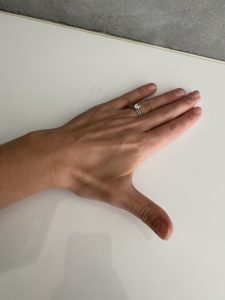DE QUERVAIN'S TENOSYNOVITIS
What is it?
De Quervain’s Tenosynovitis (DTS) occurs when two tendons at the base of your thumb – Abductor Pollicis Longus (APL) and Extensor Pollicis Brevis (EPB) become inflamed and swollen. These tendons are responsible for thumb abduction (taking thumb away from the index finger) and extension (lifting thumb up and out). When these tendons are constantly and repetitively under strain there will be inflammation of the tendon sheath and symptoms can start to occur.
Causes
DTS typically occurs as a result of overuse and repetitive movements which involve thumb abduction and extension. When you do this movement, you will typically see two tendons popping up at the base of your thumb. Mothers tend to use their thumb in this way repetitively and for prolonged periods when they are holding, lifting and breastfeeding their baby which is why this condition is quite common in the postnatal population. Pregnant women can also experience DTS as a result of increased fluid throughout the body which puts increased pressure on the APL and EPB tendons.
Symptoms
- Pain, tenderness and sometimes swelling at the base of the thumb

- Symptomatic movements typically include:
- Lifting and holding baby
- Breastfeeding baby
- Turning / grasping objects
- Holding onto the steering wheel when driving
Physiotherapy treatment options
-
- Hot / cold therapy
- This will assist with managing inflammation and pain relief around the affected area
- Compression
- Compression garments will provide support and assist with managing inflammation within the affected area
- Splinting / bracing
- DTS splints specifically keep the wrist in a neutral position. DTS splints typically have a hard plate on the outside of the thumb which stop the thumb from abducting and extending – effectively managing symptoms.
- The time of day and specific use of your splint will be in line with the nature of your symptoms
- Effleurage massage
- Effleurage can effectively reduce inflammation and fluid build up around the affected area which can reduce pain and symptoms
- Lymphatic drainage
- Draining the surrounding lymphatic system can assist with the removal of excess fluid and inflammation
- Ergonomic alteration as indicated
- This is highly tailored and specific to your needs however your physio will be looking at the repetitive tasks that you do daily and altering these so that your thumb isn’t getting into an abducted and extended position.
- Hot / cold therapy
Other treatment options
- Anti-inflammatory medications
- Always speak with your doctor or pharmacist regarding whether medications are appropriate for you, however anti-inflammatory medications can effectively reduce excess inflammation as a result of overuse and can manage pain effectively
- Steroid injections – to locally reduce the inflamed area
- Surgery – to open the sheath around the affected tendons so that they can slide and glide without restriction and pain


